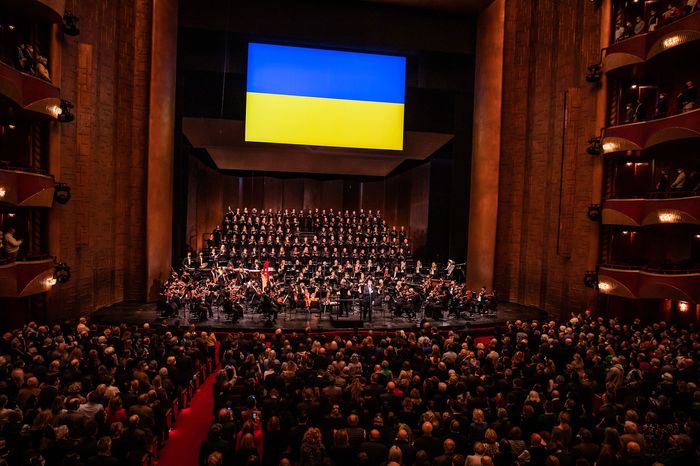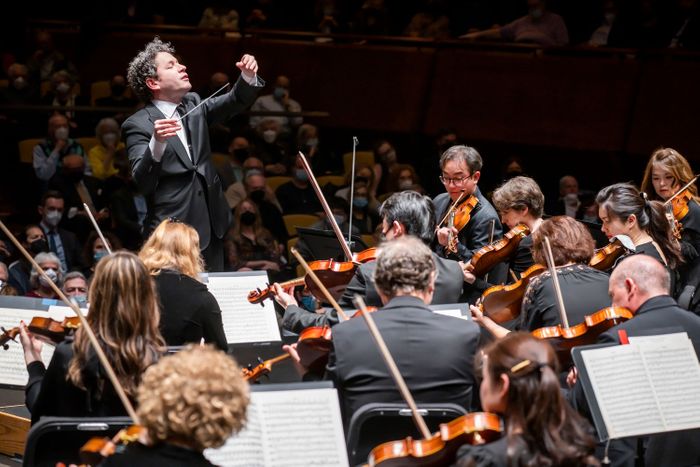
At a time when so many thoughtless habits — going online, traveling, even breathing — have become a source of threat, there’s wonder in old rituals. You may think it hopeless for symphony orchestras to try staying current in the ways they usually do, but this was a week in which custom and commitment aligned to produce some special effects. I attended three concerts all by ensembles constituted in the 19th century led by white men in their 40s, playing music from the 1820s (Beethoven), 1830s (Berlioz), and 1840s (Schumann). I have heard those pieces many times before in subtly but not radically different interpretations, in similar halls, accompanied by similar rituals. A time traveler from a century ago could have walked into any of those events and sighed in contented recognition. And yet each performance somehow felt urgent, fresh, and moving.
That was partly due to the presence on each program of one recent piece that threw old ones into relief and because, after a long COVID-induced sabbatical, the novelty of hearing a live orchestra in a full hall hasn’t yet worn off. Also, even the most heavily traveled scores are new to some; every audience includes listeners who come to Beethoven’s Ninth Symphony for the first time and whose sense of discovery is infectious. Mostly, though, the old can sound novel when musicians approach it like children unwrapping gifts: Even though they know what’s coming, their excitement blazes through.
The week began with the Metropolitan Opera’s A Concert for Ukraine on March 14, performed beneath an enormous blue-and-yellow flag and broadcast live around the world as a form of collective empathy. You could feel the sorrow and purpose that shaped those sounds: the reverent vibrato of Samuel Barber’s Adagio for Strings, the hushed longing for home of the chorus “Va, Pensiero,” from Verdi’s Nabucco. Soprano Lise Davidsen sang Strauss’s Four Last Songs with a mixture of tenderness and power that seemed to embrace mortality yet defy the grotesque images of death coming from Ukraine. In a segue from mournfulness to exuberance, Met music director Yannick Nézet-Séguin led a sparking, spangled performance of the choral movement from Beethoven’s Ninth. I imagined those sounds roaring out of radios in the middle of a restless night in Kyiv, bringing a dram of solace.
Minutes later, I hustled out of the Met and over to Carnegie Hall in time to hear the Boston Symphony Orchestra open its concert with Charles Ives’s ever-timely distillation of uncertainty from 1908, The Unanswered Question. Distant strings heard faintly through an open door, a quiet trumpet in the balcony, and a huddle of wind instruments on the vast stage turned the hall into a great resonating chamber, alive with inchoate whispers.
Catching this de facto double feature meant leaping from stirring and sober music for wartime to a bout of long-planned high drama, but if the two felt continuous it was because they both seemed designed to accompany troubled nocturnal wanderings. The Korean German composer Unsuk Chin’s new violin concerto, subtitled “Shards of Silence” and played with blistering virtuosity by Leonidas Kavakos, evoked flares bursting in the darkness. The orchestra expanded the violin’s dreamscape. A solo note bloomed into an aurora borealis. Great tree-trunk-like chords, rooted by percussive thumps, grew shivering filigrees of sound. I got lost in all this agitated mystery, impatient for a view to the piece’s destination, but the rest of the audience was evidently swept along: Chin’s work was greeted with ovations that made even her rowdiest passages seem muffled.
It’s common practice to follow a meaty contemporary concerto with a certified symphonic masterwork, allowing listeners to leave the hall fortified with familiar tunes. But BSO music director Andris Nelsons led Berlioz’s Symphonie Fantastique in a performance that summoned its night sweats, terrors, and creepy-crawlies. That work, too, is fragmented and quasi-psychotic, and the BSO played it as if all those serrated edges had never been smoothed by sheer repetition.
A few days later, conductor Gustavo Dudamel returned to the New York Philharmonic for the second part of a two-week survey of Schumann’s four symphonies. (This time, we heard Nos. 3 and 4, separated by Andreia Pinto Correia’s clattering, disjointed The Birds of Night — yet another invocation of insomnia.) The Philharmonic’s home is under renovation and won’t reopen until October, so the orchestra is couch-surfing this year, shuttling back and forth between Rose Hall and Alice Tully Hall. It’s looking for a leader, too. This encounter with Dudamel — whose contract as music director of the Los Angeles Philharmonic expires in 2026 — doubled as a peek into a possible new era.
Dudamel is a reliable supplier of excitement, and his version of Schumann’s Fourth had the quality of a car-chase sequence, a choreographed simulation of danger with no time to exhale. Even when he’s not piloting the orchestra especially fast, he guns the cellos and summons gleaming bleats of brass that give each moment a careening momentum. If he misses some opportunities for delicacy and rose-sniffing along the way, that’s a trade-off he’s willing to make, and the orchestra seemed to relish the drama. That’s the mystery of hearing a symphony live: Surprise is always a possibility.



